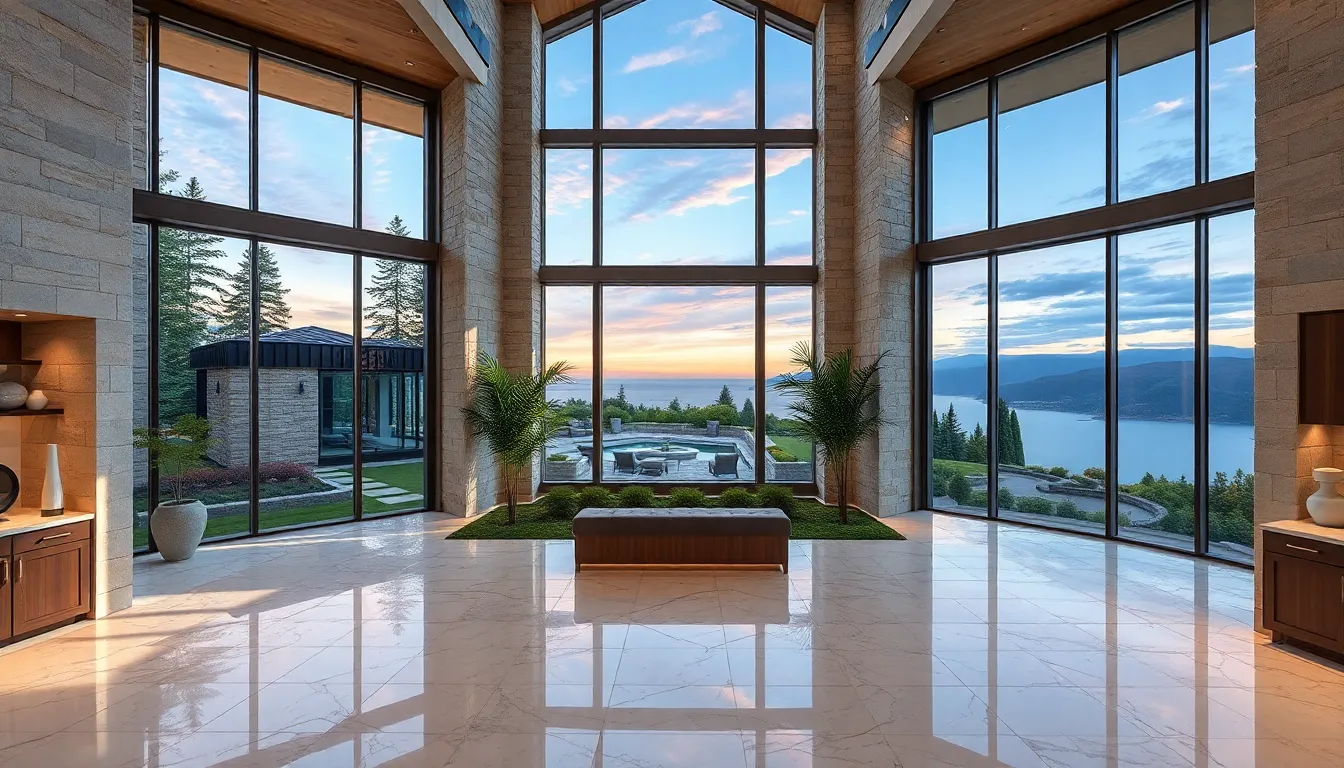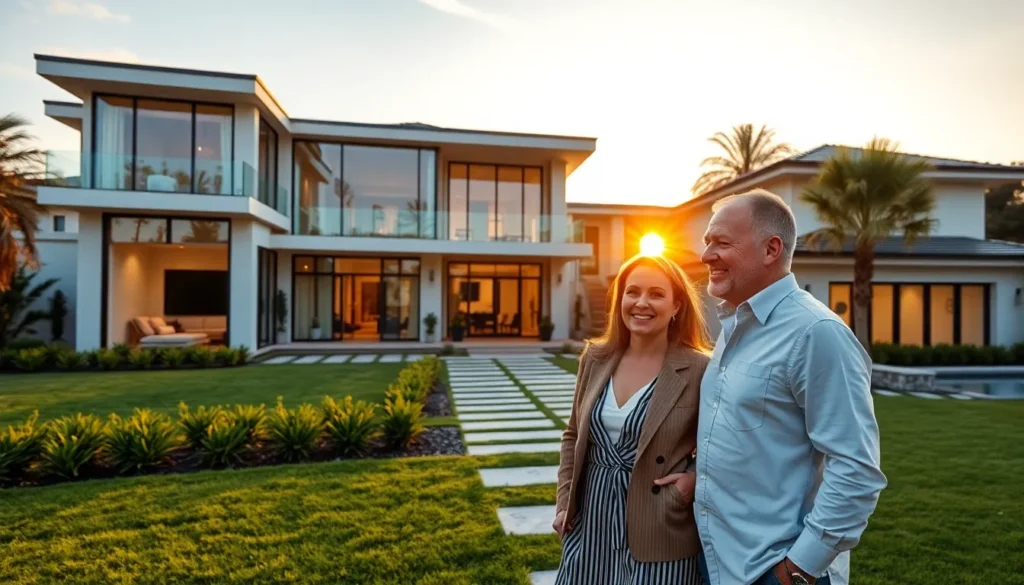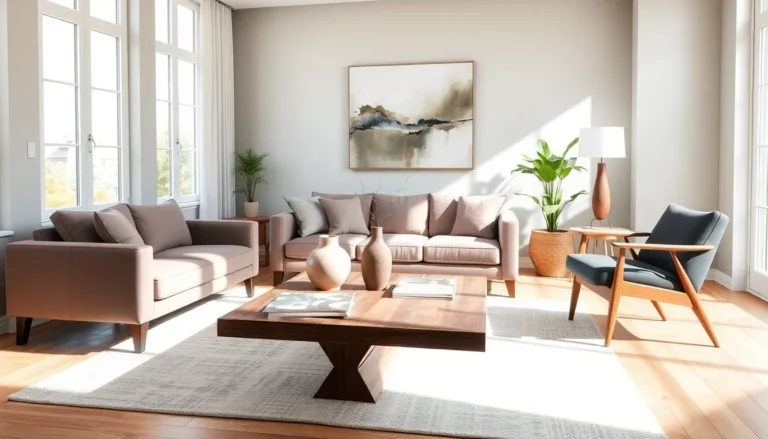High-end homes aren’t just structures; they’re the ultimate status symbols that scream luxury and sophistication. Imagine walking into a space where every corner is designed with precision and every feature whispers, “I’ve arrived.” From sprawling estates with breathtaking views to sleek penthouses that redefine urban living, these homes offer a lifestyle that’s as much about comfort as it is about prestige.
But let’s be real—who wouldn’t want a home that feels like a five-star resort? Whether it’s a gourmet kitchen that could make Gordon Ramsay weep or a home theater that rivals the local cinema, high-end homes turn everyday living into an extraordinary experience. So buckle up as we explore the world of luxury real estate, where opulence meets innovation, and your dream home might just be a few scrolls away.
Table of Contents
ToggleOverview of High-End Homes
High-end homes represent the pinnacle of luxury living. These properties often feature exquisite architecture and high-quality materials. Elaborate designs create a sense of sophistication that resonates with discerning buyers. Expansive estates frequently boast stunning views of natural landscapes, while modern penthouses offer breathtaking cityscapes.
Amenities found in these homes elevate the living experience. Gourmet kitchens allow for culinary exploration and entertainment. Home theaters provide immersive movie experiences, rivaling commercial cinemas. Pools and spas enhance relaxation, transforming a backyard into a personal oasis. Smart home systems offer convenience and security, showcasing innovation in luxury living.
The luxury real estate market thrives on exclusivity and customization. Each property often reflects its owner’s unique taste and lifestyle. Buyers typically seek tailored features that align with their preferences, from eco-friendly designs to advanced technology integrations.
The allure of high-end homes extends beyond aesthetics. Living in such properties symbolizes a lifestyle of success and achievement. Investment opportunities in this segment of the market continue to grow. High-end homes often retain their value or appreciate significantly over time, making them lucrative assets.
Ultimately, high-end homes combine elegance, comfort, and cutting-edge craftsmanship. They appeal to those ready to indulge in a lifestyle marked by sophistication and style.
Key Features of High-End Homes

High-end homes showcase unique features that set them apart, embodying luxury and sophistication in every aspect. Architectural design and interior finishes play pivotal roles in creating this allure.
Architectural Design
Exquisite architectural design defines high-end homes. Custom layouts capture attention with their grand entryways and high ceilings. Unique elements like open floor plans enhance flow and functionality. Natural light floods living spaces through expansive windows showcasing breathtaking views. Materials like stone and wood exhibit superior craftsmanship and durability. Sustainability often finds a place in the design, utilizing energy-efficient systems and eco-friendly practices. Curated landscapes complement the architecture, ensuring seamless integration with the environment.
Interior Finishes
Interior finishes in high-end homes elevate everyday living. High-quality materials like marble, hardwood, and premium tiles grace floors and countertops. Custom cabinetry and built-ins provide both aesthetics and functionality, maximizing storage. Smart home technology integrates seamlessly with interior design, allowing for easy control of lighting and climate. Luxurious textiles in furnishings and window treatments enhance comfort and style. Thoughtful color palettes create sense of harmony and elegance throughout each space. Attention to detail fosters an environment that caters to a refined lifestyle, appealing to discerning buyers.
Popular Locations for High-End Homes
High-end homes can be found in diverse locations, each offering unique appeals and experiences.
Urban Luxury Living
Urban settings often attract luxury home buyers seeking vibrant lifestyles. Cities like New York, Los Angeles, and Miami feature premium penthouses and sophisticated condos. Homeowners enjoy proximity to cultural hubs, dining, and entertainment. Architectural designs in these areas often embrace modern aesthetics with sleek finishes. Amenities such as rooftop pools and state-of-the-art gyms further enhance urban living. Locations within major metropolitan areas provide convenient access to business districts, making them ideal for professionals. Properties here represent a blend of luxury with dynamic city energy.
Suburban Retreats
Suburban areas appeal to families searching for spacious, peaceful living. Places like Beverly Hills, Greenwich, or the Hamptons showcase expansive estates in tranquil settings. These homes often come with large yards and privacy, allowing for outdoor activities and family gatherings. Traditional architectural styles coexist with modern designs, catering to various tastes. Many suburban communities offer exclusive amenities, such as country clubs and golf courses. Proximity to quality schools and parks contributes to their desirability. Buyers in these regions prioritize space and comfort, setting the stage for a luxurious lifestyle away from the hustle of city life.
Market Trends in High-End Homes
The luxury real estate market shows consistent growth, with high-end homes becoming increasingly sought after. Buyers prioritize unique design elements and high-quality features that reflect personal tastes. Current trends indicate a rising demand for sustainable and energy-efficient homes, appealing to environmentally conscious purchasers.
Customization plays a vital role in attracting buyers, as bespoke layouts cater to specific lifestyles. Rising interest in smart home technology enhances convenience, with automation features gaining popularity in luxury residences. High-end properties often include outdoor living spaces, with pools and landscaped gardens that provide private retreats.
Emerging luxury markets can be found in suburban areas, where spacious homes attract families desiring tranquility and comfort. Buyers often gravitate towards locations with strong community ties and access to high-end amenities. Urban settings continue to captivate investors as well, with penthouses offering expansive views and proximity to cultural and entertainment hubs.
Properties in luxury segments maintain solid value, often experiencing appreciation over time. Statistics indicate that high-end homes can yield a return on investment due to their exclusivity and unique characteristics. Developers focus on high-quality materials and architectural integrity, which appeal to discerning buyers investing in long-term assets.
Ultimately, market trends in high-end homes reveal a shift toward sustainability, customization, and technological innovation. Affluent consumers seek properties that not only embody luxury but also align with modern living standards and personal lifestyles.
The Buying Process for High-End Homes
Navigating the buying process for high-end homes involves several critical steps. First, securing a knowledgeable real estate agent familiar with luxury properties is essential. This professional can provide insights into off-market listings, helping buyers find exclusive opportunities.
Next, buyers usually assess their financial readiness. It’s common for them to obtain pre-approval for a mortgage or explore cash purchase options. High-end homes typically require significant financial investment, often involving several million dollars.
Investors often begin their property search by establishing clear criteria. They identify preferred locations, specific features, and desired amenities. Factors include proximity to schools, shopping areas, or cultural landmarks, enhancing overall lifestyle appeal.
Scheduling property viewings follows, with a focus on multiple visits to various homes. Each visit allows potential buyers to evaluate the layout, quality of finishes, and overall condition. Conversations with current owners may yield valuable insights into the neighborhood and property history.
Once a suitable home is identified, buyers typically conduct thorough inspections. This phase identifies any necessary repairs or renovations, ensuring the investment is sound. Engaging specialists, such as home inspectors or contractors, often occurs during this evaluation.
Negotiation comes into play after inspections, with buyers and sellers discussing terms. Offers may include contingencies based on inspection results or financing approval. Successful negotiations culminate in a finalized purchase agreement.
Closing the deal requires additional paperwork, usually handled by legal professionals. Buyers should anticipate closing costs, including title fees and taxes, which can add up significantly. After closing, homeowners can revel in the luxurious lifestyle associated with high-end living, appreciating their investment for years to come.
High-end homes offer a unique blend of luxury and sophistication that appeals to discerning buyers. With their exquisite designs and premium features these properties elevate everyday living to an extraordinary level. The emphasis on sustainability and smart technology reflects modern preferences while ensuring a comfortable lifestyle.
As the luxury real estate market continues to thrive buyers can expect a diverse range of options that cater to their individual tastes and lifestyles. Whether in bustling urban centers or tranquil suburban retreats these homes stand as symbols of success and achievement. Investing in high-end properties not only provides a lavish living experience but also represents a sound financial decision for the future.






